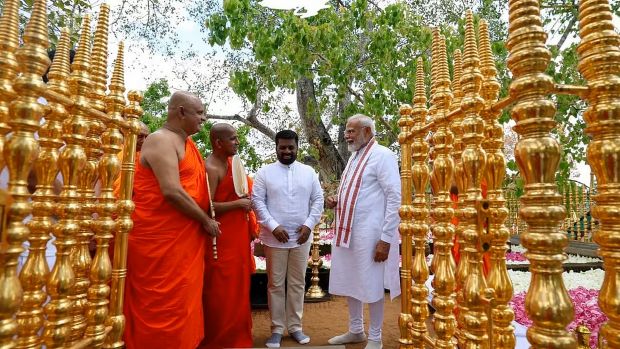Anuradhapura’s awakening: Turning history into a global opportunity
Modi’s historic visit opens a rare window to transform Sri Lanka’s spiritual heartland into a regional powerhouse of tourism, investment, and cultural diplomacy
By Prof. Manoj Samarathunga
Anuradhapura, one of the most sacred and historically significant cities in Sri Lanka, has once again found itself in the national spotlight—this time not merely as a spiritual capital but as a potential catalyst for regional economic development and international tourism. The recent visit of Indian Prime Minister Narendra Modi to this ancient city marks a historic milestone, laden with deep political, economic, and cultural significance. Yet, as with many past turning points, a critical question resurfaces: Are we prepared to seize this opportunity, or are we poised to let it slip away once again?
Despite its immense religious and archaeological value, Anuradhapura remains underrepresented in the country’s tourism narrative. According to the Sri Lanka Tourism Development Authority, in 2024, the country welcomed 2,053,456 international tourists. Of this total, only about 72,855—just 3.55%—visited Anuradhapura. In contrast, Polonnaruwa attracted 204,834 visitors (9.97%), while Sigiriya drew 508,653 tourists (24.77%), highlighting a stark disparity. These statistics point to a troubling truth: unlike its heritage counterparts, Anuradhapura has yet to achieve meaningful visibility or growth as a tourism hub.
Against this backdrop, Modi’s visit offers a timely platform to reposition Anuradhapura—not just as a spiritual destination, but as a vibrant node within South Asia’s cultural and tourism map. This moment must be more than ceremonial; it should inspire a strategic shift in how Anuradhapura is promoted, experienced, and sustained. By aligning with India’s expanding outbound tourism market and investing in storytelling, immersive experiences, and infrastructure, Anuradhapura can launch a new chapter – one that blends cultural reverence with economic vitality.
A Rare Diplomatic and Economic Window
Prime Minister Modi’s visit to Anuradhapura was no ordinary political engagement. It was strategically planned, symbolically rich, and diplomatically significant. Departing for India from Anuradhapura via a specially-designated international airstrip—an ad-hoc transformation of the city’s domestic airport—he reinforced the message that Anuradhapura is not just a historical monument, but a city of the future. With immigration and emigration protocols temporarily in place, Anuradhapura technically operated as an international airport for a day, creating a powerful image for both Sri Lankans and the international community.
India, a nation with over one million millionaires and an ever-growing middle class with a hunger for spiritual and cultural tourism, now knows about Anuradhapura. The city has officially entered the Indian public consciousness, presenting a rare opportunity to position it as a must-visit spiritual destination for Indian and global travellers alike.
Lessons from India’s Start-up Boom
The Indian model of economic rejuvenation through strategic investment, especially in the start-up sector, offers compelling lessons. Over the past six months alone, India has seen the launch of over 6,000 start-ups, many of which received up to 50% seed funding from the government, with the remaining capital provided through low-interest loans. The potential for replicating such a model in Anuradhapura—especially in tourism-related enterprises—is immense. Imagine an Investor Forum held in Anuradhapura, bringing in Indian entrepreneurs and Sri Lankan innovators to co-develop ventures in eco-tourism, hospitality, wellness retreats, and heritage conservation.
Tourism Planning: A Persistent Blind Spot
Tourism, unfortunately, continues to be misunderstood by many local authorities. It is often reduced to simplistic ideas—constructing roads, printing brochures, or organizing low-impact events. But true tourism planning is far more sophisticated and nuanced. It involves long-term strategy, destination branding, stakeholder engagement, sustainability considerations, and above all, understanding the psychology and expectations of the modern traveller.
One of the clearest signs of the gap in strategic tourism thinking was a lack of participation in major national and international travel fairs and tourism exhibitions—an ideal platform designed to connect regional tourism offerings with both local and international markets. Such events provide a unique space to present destinations through powerful narratives, cultural connections, and immersive experiences that go far beyond traditional brochures and exhibition booths. Unfortunately, these opportunities are often overlooked. With a more creative and forward-thinking approach, Anuradhapura could have used such a platform to position itself as a spiritual and investment destination, especially in light of growing interest from regional travellers and international investors. The absence from these spaces reflects a broader issue: the lack of understanding that modern tourism success depends on vision, storytelling, and strategic engagement.
The Bigger Picture that Keeps Getting Missed
For over a decade, Anuradhapura has struggled to break free from a cycle of underutilization and poor positioning. Despite its UNESCO World Heritage Site status, the city fails to project itself as a globally competitive destination. There are no large-scale public-private partnership projects that amplify its value. No major international hotel chains have been invited to establish cultural retreats. No festivals of global standard have been created around its Poya days or archaeological marvels. And still, the outdated perception of tourism as “just a local affair” continues to limit our collective imagination.
It is disheartening to see a city of such potential continue to miss out simply because key decision-makers lack the vision to see beyond traditional tourism models. Even basic destination branding efforts—logos, slogans, signature campaigns—are either missing or disconnected from modern tourism trends.
Political Will and Media Engagement: A Crucial Gap
During Modi’s visit, many assumed that national-level political movements, particularly those with a strong media presence like the National People’s Power (NPP), would seize the opportunity to launch a nationwide narrative on Anuradhapura’s transformation. But that did not happen. Instead, the event passed with minimal public engagement beyond diplomatic circles.
Credit must be given, however, to President Anura Kumara Dissanayake for ensuring that this moment took place and that Anuradhapura was dignified as the departure point for one of the world’s most prominent political leaders. His gesture was symbolic but powerful, offering a launchpad for something bigger—if only we had the foresight to use it.
Time to Act: A Proposal for the Future
What Anuradhapura needs now is not just inspiration, but implementation. Here are five immediate steps that could be taken:
- Host an Indo-Lanka Investor Forum in Anuradhapura
Invite Indian entrepreneurs and venture capitalists to explore investment opportunities in tourism, agriculture, and services. - Establish a Tourism Innovation Incubator
Support local start-ups with seed funding, mentorship, and access to regional and international markets. - Design a Strategic Tourism Plan for 2025–2030
With input from international experts and local communities, build a roadmap that includes spiritual tourism, religious tourism, wellness tourism, cultural festivals, and digital tourism promotion. - Activate the Anuradhapura Airport as a Seasonal International Entry Point
Use the existing infrastructure and political precedent to initiate charter flights during peak pilgrimage seasons. - Invest in Destination Branding and International Marketing
Collaborate with global agencies to create a cohesive brand identity for Anuradhapura that appeals to Indian, Southeast Asian, and Western spiritual travellers.
Anuradhapura stands at a historic crossroads. The visit of Prime Minister Narendra Modi has opened a diplomatic and economic doorway that may not remain open for long. While the potential is immense, the lack of proactive planning, creative promotion, and visionary leadership continues to drag the city back into a cycle of missed opportunities. The time to act is now. The world is watching, India is listening, and Anuradhapura is ready—if only we are wise enough to see the path ahead.

.
-Prof. Manoj Samarathunga is a Professor at the Department of Tourism & Hospitality Management, Faculty of Management Studies, Rajarata University of Sri Lanka, Mihintale and can be reached via: manoj.susl@gmail.com



Comments are closed, but trackbacks and pingbacks are open.